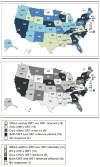Methadone and buprenorphine prescribing and referral practices in US prison systems: results from a nationwide survey
- PMID: 19625142
- PMCID: PMC2743749
- DOI: 10.1016/j.drugalcdep.2009.06.015
Methadone and buprenorphine prescribing and referral practices in US prison systems: results from a nationwide survey
Erratum in
-
Corrigendum.Drug Alcohol Depend. 2011 Jan 15;113(2-3):252. doi: 10.1016/j.drugalcdep.2010.07.002. Drug Alcohol Depend. 2011. PMID: 21479159 Free PMC article. No abstract available.
Abstract
Background: More than 50% of incarcerated individuals have a history of substance use, and over 200,000 individuals with heroin addiction pass through American correctional facilities annually. Opiate replacement therapy (ORT) with methadone or buprenorphine is an effective treatment for opiate dependence and can reduce drug-related disease and recidivism for inmates. Provision of ORT is nevertheless a frequently neglected intervention in the correctional setting.
Objective and methods: We surveyed the 50 state; Washington, District of Columbia (DC); and Federal Department of Corrections' medical directors or their equivalents about their facilities' ORT prescribing policies and referral programs for inmates leaving prison.
Results: We received responses from 51 of 52 prison systems nationwide. Twenty-eight prison systems (55%) offer methadone to inmates in some situations. Methadone use varies widely across states: over 50% of correctional facilities that offer methadone do so exclusively for pregnant women or for chronic pain management. Seven states' prison systems (14%) offer buprenorphine to some inmates. The most common reason cited for not offering ORT was that facilities "prefer drug-free detoxification over providing methadone or buprenorphine." Twenty-three states' prison systems (45%) provide referrals for some inmates to methadone maintenance programs after release, which increased from 8% in 2003; 15 states' prison systems (29%) provide some referrals to community buprenorphine providers.
Conclusion: Despite demonstrated social, medical, and economic benefits of providing ORT to inmates during incarceration and linkage to ORT upon release, many prison systems nationwide still do not offer pharmacological treatment for opiate addiction or referrals for ORT upon release.
Figures
References
-
- Auriacombe M, Fatseas M, Dubernet J, Daulouede JP, Tignol J. French field experience with buprenorphine. Am J Addict. 2004;12 1:S17–28. - PubMed
-
- Auriacombe M, Franques P, Tignol J. Deaths attributable to methadone vs buprenorphine in France. JAMA. 2001;285:45. - PubMed
-
- Bick J. HIV and Viral Hepatitis in Corrections: A Public Health Opportunity. In: Greifinger R, editor. Public Health Behind Bars. Springer International; New York: 2007.
-
- Bird SM, Hutchinson SJ. Male drugs-related deaths in the fortnight after release from prison: Scotland, 1996-99. Addiction. 2003;98:185–190. - PubMed
Publication types
MeSH terms
Substances
Grants and funding
- T32 DA013911/DA/NIDA NIH HHS/United States
- 1R01DA018641-01/DA/NIDA NIH HHS/United States
- K24 DA022112/DA/NIDA NIH HHS/United States
- 5T32DA13911/DA/NIDA NIH HHS/United States
- P30 DA013868/DA/NIDA NIH HHS/United States
- 1K24DA022112-01A/DA/NIDA NIH HHS/United States
- R01 DA018641/DA/NIDA NIH HHS/United States
- L60 MD003501/MD/NIMHD NIH HHS/United States
- P30DA013868/DA/NIDA NIH HHS/United States
- K01 AA020228/AA/NIAAA NIH HHS/United States
- P30-AI-42853/AI/NIAID NIH HHS/United States
- P30 AI042853/AI/NIAID NIH HHS/United States
LinkOut - more resources
Full Text Sources
Other Literature Sources
Medical


